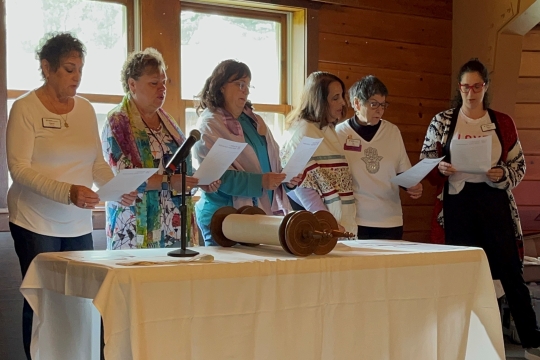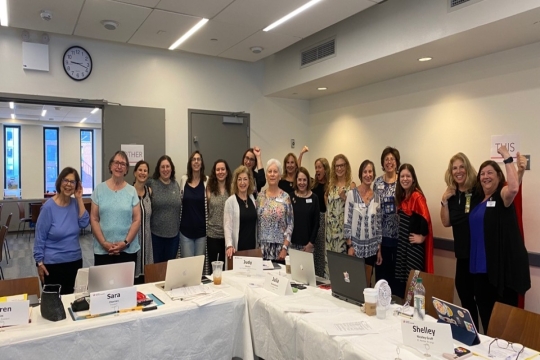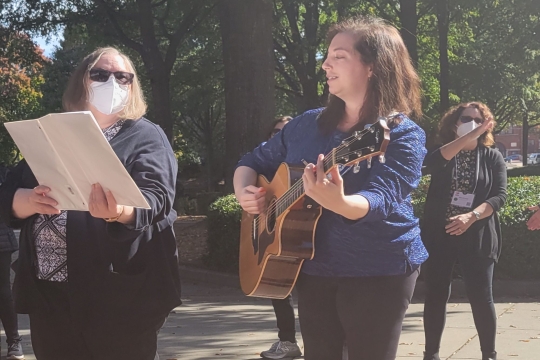It’s a season of change for many in our sisterhoods ―transition from school to summer, from existing leadership to new leadership, and from a calendar full of activities to a time when we can slow down and reflect a bit. This transition time offers an opportunity to focus on how we can learn from this week’s Torah portion relative to the way we work together, to learn, to grow, and to strive for harmony and balance in times of change.
The Torah portion this week is B’haalot’cha in the book of Numbers 8:1–12:16. The parashah covers a lot of ground – telling of light in the Tabernacle, consecration of the Levites, the second Passover, how a cloud and fire led the Israelites, the silver trumpets, how the Israelites set out on their journeys, complaining by the Israelites, and how Miriam and Aaron questioned Moses. It’s chock full of goodies, but I’d like to focus on one key symbolic element that we can relate directly to our sisterhood women, our ideals, and our purpose.
In the very beginning of the parashah, God tells Moses to instruct Aaron to place the seven lamps so as to create light in the Tabernacle –B’haalot’cha literally means to “bring up” and is referencing mounting the lamps.
Now, let’s create some imagery that we can tie into. The portion states, “Aaron mounts the lamps and reaches out to light the menorah in the tabernacle.” This is similar to the women of sisterhoods who reach out and lift each other up.
The portion continues, “The ark is finished so that the Israelites are now able to focus on serving God’s commandments.” This relates to when WRJ comes together to foster an organization and a bond that allows us to service the needs of our community and our world.
The last part of this section states, “And finally, God instructs Moses to assemble the Israelite community leadership and bring the Levites before God as they are blessed for service.” Reform Jewish women gather before our communities to pledge our dedication to service as an example of this assembly. We are the light, the promise, and we serve to ensure the future.
Kavannah is the Hebrew word for intention, and generally refers to being fully immersed in prayer. I’d like to take that a bit further and consider Kavannah as being fully committed to an intention for “lifting each other up.” The ancient verbal root of Kavannah has the object or subject as the "heart.” The word connotes "to direct the heart.” The English word courage is from the French “coeur” meaning heart. Socrates said that “courage is a sort of endurance of the soul” and the ancient Romans considered it one of four key virtues – wisdom, justice, temperance and courage. With these ideas in mind, we can see the heart as a metaphor for inner strength.
When we gather together, we realize that all of us are busy, dealing with the various distractions, demands, and stresses of life, so I propose that setting an intention is not about what we want to accomplish. Rather, it is about the heart of the matter, essentially how we intend to show up for each other, how we support each other, and how we forge the connections that allow us to thrive.
Taking a moment to set intentions is a reminder not to try and rid ourselves of life’s obstacles and not to eliminate the trials of living (because that will not happen, not in this lifetime!). In being human, it is our job to embrace those challenges, to help each other recognize what is weighing us down, and to find the means for realizing those challenges as a precious gift. The Israelites took on the tasks they were given and they elevated themselves to a higher level; we do the same.
So, what does it look like to set intentions? It could be making a commitment to fully listen to each other, to acknowledge each other’s contributions, to be present at any given moment, and even to ask for help. It could be taking a stand, taking a risk, or finding the courage to speak up when it is uncomfortable or inconvenient.
How do we follow up on our intentions? We can start by speaking of them, sharing them with others, inviting others to join in, and allowing those others to support our efforts.
Torah brings us together and its lessons encourage us all to be more focused on our Kavannah, our intentions as we go about “lifting each other up,” much as Aaron reaches out to light the lights of the tabernacle in B’haalotcha. We each have the means to create the possibility of kind, meaningful relationships that allow us to lift up and build community.
Pamela Lear is Immediate Past President of the Sisterhood of Temple Beth Am in Miami, FL. She currently serves as an Area Director on the WRJ SE District Board and is on the North American Board of WRJ.
Related Posts

Parashat Yom Rishon shel Rosh HaShanah

Cultivating a Culture of Accountability and Belonging

